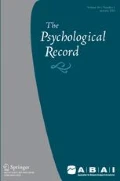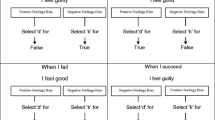Abstract
The current study reports the findings of an experiment in which adolescents’ explicit and implicit attitudes toward cyberbullying were explored. Participants first completed an explicit measure of their attitudes toward cyberbullying, followed by an implicit measure in the form of the Implicit Relational Assessment Procedure (IRAP). Results revealed that participants displayed a combination of anti- and pro-cyberbullying attitudes. There was no statistically significant correlation between participants’ implicit and explicit attitudes toward cyberbullying. The current findings may have important implications for our understanding of adolescents’ attitudes toward cyberbullying and the development of relevant educational programs.


Similar content being viewed by others
References
Barnes-Holmes, D., Barnes-Holmes, Y., Stewart, I., & Boles, S. (2010). A sketch of the implicit relational assessment procedure (IRAP) and the relational elaboration and coherence (REC) model. The Psychological Record, 60, 527–542.
Barnes-Holmes, D., Murphy, A., Barnes-Holmes, Y., & Stewart, I. (2010). The implicit relational assessment procedure: Exploring the impact of private versus public contexts and the response latency criterion on pro-white and anti-black stereotyping among white Irish individuals. The Psychological Record, 60, 57–79.
Bast, D. F., Barnes-Holmes, Y., & Barnes-Holmes, D. (2015). Developing an individualized implicit relational assessment procedure (IRAP) as a potential measure of self-forgiveness related to negative and positive behavior. The Psychological Record, 65, 717–730.
Brighi, A., Ortega, R., Scheitauer, H., Smith, P. K., Tsormpatzoudis, C., Barkoukis, V., & Del Rey, R. (2012a). European cyberbullying intervention project questionnaire (ECIPQ). Unpublished manuscript, Bologna: University of Bologna.
Brighi, A., Ortega, R., Scheitauer, H., Smith, P. K., Tsormpatzoudis, C., Barkoukis, V., & Del Rey, R. (2012b). European bullying intervention project questionnaire (EBIPQ). Unpublished manuscript, Bologna: University of Bologna.
Cullen, C., Barnes-Holmes, D., Barnes-Holmes, Y., & Stewart, I. (2009). The implicit relational assessment procedure (IRAP) and the malleability of ageist attitudes. The Psychological Record, 59, 591–620.
Drake, C. E., Kramer, S., Habib, R., Schuler, K., Blankenship, L., & Locke, J. (2015). Honest politics: Evaluating candidate perceptions for the 2012 U.S. election with the implicit relational assessment procedure. Journal of Contextual Behavioral Science, 4, 129–138.
Farrell, L., Cochrane, A., & McHugh, L. (2015). Exploring attitudes towards gender and science: The advantages of an IRAP approach versus the IAT. Journal of Contextual Behavioral Science, 4, 121–128.
Farrell, L., & McHugh, L. (2017). Examining gender-STEM bias among STEM and non-STEM students using the Implicit Relational Assessment Procedure (IRAP). Journal of Contextual Behavioral Science, 6, 80–90.
Greenwald, A. G., McGhee, D. E., & Schwartz, J. L. K. (1998). Measuring individual differences in implicit cognition: The implicit association test. Journal of Personality and Social Psychology, 74, 1464–1480.
Greenwald, A. G., Nosek, B. A., & Banaji, M. R. (2003). Understanding and using the implicit association test: I. An improved scoring algorithm. Journal of Personality and Social Psychology, 85, 197–216.
Grigg, D. W. (2010). Cyber-aggression: Definition and concept of cyberbullying. Journal of Psychologists and Counsellors in Schools, 20, 143–156.
Hayes, S. C., Barnes-Holmes, D., & Roche, B. (2001). Relational frame theory: A post-Skinnerian account of human language and cognition. New York: Academic Springer Science & Business Media.
Hinduja, S., & Patchin, J. W. (2007). Offline consequences of online victimization: School violence and delinquency. Journal of School Violence, 6, 89–112.
Hinduja, S., & Patchin, J. W. (2008a). Cyberbullying: An exploratory analysis of factors related to offending and victimization. Deviant Behavior, 29, 1–29.
Hinduja, S., & Patchin, J. W. (2008b). Personal information of adolescents on the internet: A quantitative content analysis of MySpace. Journal of Adolescence, 31, 125–146.
Hinduja, S., & Patchin, J. W. (2010). Bullying, cyberbullying, and suicide. Archives of Suicide Research, 14, 206–221.
Hinduja, S., & Patchin, J. W. (2014). Cyberbullying identification, prevention, and response. Retrieved from https://cyberbullying.org/Cyberbullying-Identification-Prevention-Response.pdf.
Hofmann, W., Gawronski, B., Gschwendner, T., Le, H., & Schmitt, M. (2005). A meta-analysis on the correlation between the implicit association test and explicit self-report measures. Personality and Social Psychology Bulletin, 31, 1369–1385.
Hughes, S., & Barnes-Holmes, D. (2013). A functional approach to the study of implicit cognition: The implicit relational assessment procedure (IRAP) and the relational elaboration and coherence (REC) model. In S. Dymond & B. Roche (Eds.), Advances in relational frame theory (pp. 97–125). Windermere: Context Press.
Hussey, I., Mhaoileoin, D. N., Barnes-Holmes, D., Ohtsuki, T., Kishita, N., Hughes, S., & Murphy, C. (2016). The IRAP is nonrelative but not acontextual: Changes to the contrast category influence men’s dehumanization of women. The Psychological Record, 66, 291–299.
Hussey, I., Thompson, M., McEnteggart, C., Barnes-Holmes, D., & Barnes-Holmes, Y. (2015). Interpreting and inverting with less cursing: A guide to interpreting IRAP data. Journal of Contextual Behavioral Science, 4, 157–162.
Kirwan, G., & Power, A. (2013). Cybercrime: The psychology of online offenders. Cambridge: Cambridge University Press.
Kowalski, R., Limber, S., Scheck, A., Redfearn, M., Allen, J., & Calloway, A. M. (2005). Electronic bullying among school-aged children and youth. Paper presented at the annual meeting of the American Psychological Association, Washington, DC.
Kowalski, R. M., & Limber, S. P. (2007). Electronic bullying among middle school students. Journal of Adolescent Health, 41, S22–S30.
Kowalski, R. M., & Limber, S. P. (2013). Psychological, physical, and academic correlates of cyberbullying and traditional bullying. Journal of Adolescent Health, 53, S13–S20.
Li, Q. (2007a). Bullying in the new playground: Research into cyberbullying and cyber victimisation. Australasian Journal of Educational Technology, 23, 435–454.
Li, Q. (2007b). New bottle but old wine: A research of cyberbullying in schools. Computers and Human Behavior, 23, 1777–1791.
McEnteggart, C., Barnes-Holmes, Y., & Adekuoroye, F. (2016). The effects of a voice hearing simulation on implicit fear of voices. Journal of Contextual Behavioral Science, 5, 154–159.
McKenna, I., Hughes, S., Barnes-Holmes, D., De Schryver, M., Yoder, R., & O’Shea, D. (2016). Obesity, food restriction, and implicit attitudes to healthy and unhealthy foods: Lessons learned from the implicit relational assessment procedure. Appetite, 100, 41–54.
Nicholson, E., & Barnes-Holmes, D. (2012). Developing an implicit measure of disgust propensity and disgust sensitivity: examining the role of implicit disgust propensity and sensitivity in obsessive-compulsive tendencies. Journal of Behavior Therapy and Experimental Psychiatry, 43, 922–930.
Olweus, D. (1999). Norway. In P. K. Smith, Y. Morita, J. Junger-Tas, D. Olweus, R. Catalano, & P. Sloan (Eds.), The nature of school bullying: A cross-sectional perspective (pp. 7–27). London: Routledge.
Parling, T., Cernvall, M., Stewart, I., Barnes-Holmes, D., & Ghaderi, A. (2012). Using the implicit relational assessment procedure to compare implicit pro-thin/anti-fat attitudes of patients with anorexia nervosa and non-clinical controls. Eating Disorders: The Journal of Treatment and Prevention, 20, 127–143.
Patchin, J. W., & Hinduja, S. (2010). Cyberbullying and self-esteem. Journal of School Health, 80, 616–623.
Perugini, M., & Prestwich, A. (2007). The gatekeeper: Individual differences are key in the chain from perception to behavior. European Journal of Personality, 21, 303–317.
Remue, J., De Houwer, J., Barnes-Holmes, D., Vanderhasselt, M. A., & De Raedt, R. (2013). Self-esteem revisited: Performance on the implicit relational assessment procedure as a measure of self- versus ideal self-related cognitions in dysphoria. Cognition and Emotion, 27, 1441–1449.
Roddy, S., Stewart, I., & Barnes-Holmes, D. (2010). Anti-fat, pro-slim, or both? Using two reaction-time based measures to assess implicit attitudes to the slim and overweight. Journal of Health Psychology, 15, 416–425.
Scanlon, G., McEnteggart, C., Barnes-Holmes, Y., & Barnes-Holmes, D. (2014). Using the Implicit Relational Assessment Procedure (IRAP) to assess implicit gender bias and self-esteem in typically-developing children and children with ADHD and with dyslexia. Behavioral Development Bulletin, 19, 48–59.
Slonje, R., & Smith, P. K. (2008). Cyberbullying: Another main type of bullying. Scandinavian Journal of Psychology, 49, 147–154.
Slonje, R., Smith, P. K., & Frisen, A. (2012). The nature of cyberbullying, and strategies for prevention. Computers in Human Behavior, 29, 26–32.
Smith, P. K., Madhavi, J., Carvalho, M., Fisher, S., Russell, S., & Tippett, N. (2008). Cyberbullying: Its nature and impact on secondary school pupils. Journal of Child Psychology and Psychiatry, 49, 376–385.
Timko, C. A., England, E. L., Herbert, J. D., & Forman, E. M. (2010). The implicit relational assessment procedure as a measure of self-esteem. The Psychological Record, 60, 679–698.
Timmins, L., Barnes-Holmes, D., & Cullen, C. (2016). Measuring implicit sexual response biases to nude male and female pictures in androphilic and gynephilic men. Archives of Sexual Behavior, 45, 829–841.
Vahey, N., Boles, S., & Barnes-Holmes, D. (2010). Measuring adolescents’ smoking-related social identity preferences with the implicit relational assessment procedure (IRAP) for the first time: A starting point that explains later IRAP evolutions. International Journal of Psychology and Psychological Therapy, 10, 453–474.
Vahey, N. A., Barnes-Holmes, D., Barnes-Holmes, Y., & Stewart, I. (2009). A first test of the implicit relational assessment procedure (IRAP) as a measure of self-esteem: Irish prisoner groups and university students. The Psychological Record, 59, 371–388.
van Goethem, A. A., Scholte, R. H., & Wiers, R. W. (2010). Explicit- and implicit bullying attitudes in relation to bullying behavior. Journal of Abnormal Child Psychology, 38, 829–842.
Vandebosch, H., & Van Cleemput, K. (2008). Defining cyberbullying: A qualitative research into the perceptions of youngsters. Cyberpsychology & Behavior, 11, 499–503.
Williams, K., & Guerra, N. G. (2007). Prevalence and predictors of internet bullying. Journal of Adolescent Health, 41, S14–S21.
Wilson, T. D., Lindsey, S., & Schooler, T. Y. (2000). A model of dual attitudes. Psychological Review, 107, 101–126.
Ybarra, M. L., & Mitchell, J. K. (2004). Online aggressor/targets, aggressors, and targets: A comparison of associated youth characteristics. Journal of Child Psychology and Psychiatry, 45, 1308–1316.
Ybarra, M. L., & Mitchell, K. J. (2007). Prevalence and frequency of internet harassment instigation: Implications for adolescent health. Journal of Adolescent Health, 41, 189–195.
Funding
This research was funded by an Irish Research Council grant awarded to Anita Munnelly.
Author information
Authors and Affiliations
Corresponding author
Ethics declarations
Conflict of Interest
On behalf of all authors, the corresponding author states that there are no conflicts of interest.
Ethical Approval
All procedures performed in studies involving human participants were in accordance with the ethical standards of the institutional research committee and with the 1964 Declaration of Helsinki and its later amendments or comparable ethical standards.
Informed Consent
Informed consent was obtained from all individual participants included in the study.
Rights and permissions
About this article
Cite this article
Munnelly, A., Farrell, L., O’Connor, M. et al. Adolescents’ Implicit and Explicit Attitudes Toward Cyberbullying: an Exploratory Study Using the Implicit Relational Assessment Procedure (IRAP) and Self-Report Measures. Psychol Rec 68, 1–10 (2018). https://doi.org/10.1007/s40732-017-0261-0
Published:
Issue Date:
DOI: https://doi.org/10.1007/s40732-017-0261-0




